May 2005
![]()
AutomatedBuildings.com
[an error occurred while processing this directive]
(Click Message to Learn More)
May 2005 |
[an error occurred while processing this directive] |
|
|
Mike Schell |
INTRODUCTION
Buildings and their associate ventilation systems can be a perfect delivery mechanism for airborne terrorist related threats. Alternatively, with some careful planning, buildings can be configured to protect occupants from a wide variety of threats. The challenge of properly configuring the building involves a higher degree of integration of the building control, fire and security systems than is currently typical in most buildings. As a result, the building automation specialist will play a key role in designing the protective responses of buildings.
|
|
|
|
|
|
|
|
|
|
|
|
|
|
|
|
|
|
|
|
|
|
|
[an error occurred while processing this directive] |
Before a building can initiate a response, there is a need to detect the threat. This article discusses the nature of the biological threat in buildings and what approaches are available to detect these potential threats.
The nature of a biological threat in a building is very different than a chemical or nuclear threat. The prospect of a biological release inside a building is so terrifying because there is typically an incubation period of a few days to a few weeks after exposure, before symptoms become apparent. In those days or weeks, harmful biological material can spread from a single release point to contaminate an entire building, subjecting all occupants to potential exposure. In addition, there is the effort and cost related to cleanup/remediation. As you may recall the anthrax incident in 2001, it was only after a person had died from anthrax exposure that officials started to trace back were that exposure might of occurred. The impact, and lethality of a harmful biological agent is directly related to the time that elapses after a release. If the location, time and type of agent can all be identified soon after it occurs, treatment can begin immediately and the spread of the agent can be minimized.
These types of releases can that can occur at building air intakes, inside the building or in potential high vulnerability areas like mail rooms, loading docks and unsecured lobby areas.
From a detection perspective, building owners have four general choices with respect to preparing for the possibility of a bio-threat release. These options, which are expanded upon below, include:
Doing nothing,
Employing dry filters and polymerase chain reaction (PCR) testing,
Installing an integrated biodetection system, or
Implementing a two-tiered detection approach, which includes a surveillance sensor network and confirmation testing.
This article discusses the current state of the art in biological detection in buildings including operational concepts and costs. Finally, we provide a first-hand description on MesoSystems’ AirSentinel Bio-threat Sensor for use in a two-tier surveillance network. The product is currently in a field test stage, accumulating performance data in several locations across the US, and undergoing third party testing. Commercial release is planned for late 2005. If after reading the rest of this article you have an interest in participating in the AirSentinel field test program or would like further information contact mschell@epiphanytec.com (805) 687-3175.
BIO-THREAT PROTECTION MODELS FOR BUILDING SECURITY
Threat studies exploring the potential devastation caused by easily accessible biological weapons and those with the capacity to execute such scenarios are well documented.1-3 High profile and high-occupancy buildings are vulnerable targets for such threats. Not only are biological threats lethal, they can render a building permanently uninhabitable. While the capability exists today to detect biological threats in time to mitigate widespread disaster, technology for affordable building protection solutions are in concept development stages. This paper presents the technology platforms and integrated models that are likely to be part of the typical comprehensive building protection system of the future. The target features and capabilities of the various systems are identified, as are potential concepts for operating the detection systems.
Most buildings today do not incorporate a bio-threat detection capability. In the event of a biological release, building occupants are the “canaries in the coalmine.” When individuals start showing symptoms, the building owners have visible evidence that they have a problem. Damage at this point can be significant, for not only does morbidity and mortality increase once people start showing symptoms, the building itself is rendered uninhabitable. This period of closure may last throughout a costly remediation period or it may be indefinite. In the case of spores, it is extremely difficult to completely eliminate the problem when the threat is dispersed throughout a building complex, and standards for decontamination are yet to be developed.
There are currently three approaches for the detection of bio-threat in buildings that will be explained in more detail below.
1. Dry Filters and PCR
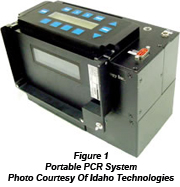
 The first approach that can be used to identify biothreats involves taking
regular samples of dry filter media in the building ventilation system and
testing those samples using a DNA test called polymerase chain reaction (PCR).
PCR is a test methodology that enables identification of organisms that are
present so that appropriate medical intervention is possible. PCR is a liquid
based analysis that typically is performed in a lab or using a desktop analysis
system. PCR is used to identify a number of likely biological threats like
anthrax, plague and tularemia. This is the approach employed by the government
in their BioWatch and BASIS programs that are used to monitor public and high
vulnerability sites. The capital equipment necessary to initiate such a program
is fairly low cost. The false alarm rate is very low, due to the fact that
laboratory testing is the confirmatory method. Should an organism be present in
the filter media, the probability that the laboratory will detect the problem,
even in small quantities, is relatively high.
The first approach that can be used to identify biothreats involves taking
regular samples of dry filter media in the building ventilation system and
testing those samples using a DNA test called polymerase chain reaction (PCR).
PCR is a test methodology that enables identification of organisms that are
present so that appropriate medical intervention is possible. PCR is a liquid
based analysis that typically is performed in a lab or using a desktop analysis
system. PCR is used to identify a number of likely biological threats like
anthrax, plague and tularemia. This is the approach employed by the government
in their BioWatch and BASIS programs that are used to monitor public and high
vulnerability sites. The capital equipment necessary to initiate such a program
is fairly low cost. The false alarm rate is very low, due to the fact that
laboratory testing is the confirmatory method. Should an organism be present in
the filter media, the probability that the laboratory will detect the problem,
even in small quantities, is relatively high.
While the initial cost is low, the operating costs and corresponding total cost of ownership are very high. For such a program to determine the presence of a threat at a stage in the incubation period where treatment is likely to be effective, the manual sampling is necessary at least every three days. In application, such a system would typically involve scheduled sample collection, delivery to a laboratory, and tracking of results. Response times of three days will enable responders to begin treatment for those exposed. However, as the air will have circulated throughout the building, such response times are ineffective for protecting assets.
2. Integrated Systems
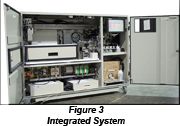 Integrated systems are typically comprised of a laser-based alarm and a
confirmation sensor that together detect, identify, and alarm in the event of a
biological threat. Such systems are in use by the Department of Defense (DoD)
and the US Postal Service. The response time is relatively fast. Because the
systems have integrated confirmatory testing, the sensitivity is relatively high
and the probability of false alarms is low. If PCR is used for the confirmatory
test the false alarm rate is very low.
Integrated systems are typically comprised of a laser-based alarm and a
confirmation sensor that together detect, identify, and alarm in the event of a
biological threat. Such systems are in use by the Department of Defense (DoD)
and the US Postal Service. The response time is relatively fast. Because the
systems have integrated confirmatory testing, the sensitivity is relatively high
and the probability of false alarms is low. If PCR is used for the confirmatory
test the false alarm rate is very low.
The equipment cost is very high due to the complexity and the number of relatively high-cost sub-assemblies that are integrated in the system. The complexity of this approach often requires highly trained personnel to operate and maintain the system. While the operating cost is typically moderate, the high capital equipment cost means that the total cost of ownership is high. Given these factors it is unlikely that this approach could easily be applied in commercial buildings. It is more applicable to high risk elements inside a building such as mail sorting machines.
3. Two-Tier Surveillance with AirSentinel Alarm and PCR Confirmation Assay
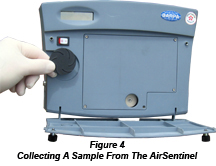 The use of low-cost sensor networks has the potential to improve response times
in buildings.4 The two-tier surveillance model as demonstrated by the
AirSentinel product developed by MesoSystems, employs a highly dispersed sensor
network (much like a smoke detection system) and PCR confirmatory testing. The
sensors are designed to be low-cost, network configurable, and operable in a
full-time surveillance mode. Such sensors are individually less sensitive than
those incorporated into the integrated detection systems, however, when
configured in a distributed network architecture, they provide a high
probability of detection. The rationale for this improvement in net performance
is that distributed sensor networks improve the likelihood that there will be a
sensor near the source of the release where the agent density is highest. The
initial cost of a network of sensors is moderate. Only one PCR confirmatory
detection system is needed for each building or grouping of buildings, keeping
capital costs low. In addition, because PCR testing is only necessary if a
sensor or sensors in the network alarm, both the operating cost and total cost
of ownership are low. PCR analysis devices are now available that can easily be
operated by trained security or building maintenance personnel.
The use of low-cost sensor networks has the potential to improve response times
in buildings.4 The two-tier surveillance model as demonstrated by the
AirSentinel product developed by MesoSystems, employs a highly dispersed sensor
network (much like a smoke detection system) and PCR confirmatory testing. The
sensors are designed to be low-cost, network configurable, and operable in a
full-time surveillance mode. Such sensors are individually less sensitive than
those incorporated into the integrated detection systems, however, when
configured in a distributed network architecture, they provide a high
probability of detection. The rationale for this improvement in net performance
is that distributed sensor networks improve the likelihood that there will be a
sensor near the source of the release where the agent density is highest. The
initial cost of a network of sensors is moderate. Only one PCR confirmatory
detection system is needed for each building or grouping of buildings, keeping
capital costs low. In addition, because PCR testing is only necessary if a
sensor or sensors in the network alarm, both the operating cost and total cost
of ownership are low. PCR analysis devices are now available that can easily be
operated by trained security or building maintenance personnel.
The device has a two phase or two tier response. In the first phase, the device samples the air every 30 seconds and looks for an unusual elevation of biological material as detected by UV florescence.
[an error occurred while processing this directive] If an elevated level is detected, a second phase response is activated. Immediately the sensor takes a physical sample of the air that can be collected for immediate PCR analysis. In addition a silent alarm is activated that could initiate the following actions.
The appropriate people can be notified that a sample must be retrieved from the unit and taken for immediate PCR analysis.
Low regret measures to reduce exposure and spread of possible biological materials can be undertaken, such as venting a particular space, activating special filtration systems or changing ventilation to prevent the spread of potentially harmful material throughout the building.
The building security infrastructure can be alerted to identify all people in the area of exposure who might need treatment if a harmful material is confirmed.
If the PCR analysis indicates a harmful material has been released, the time and place of exposure are known and exposed individuals can quickly be treated. First responders should be notified immediately. If PCR shows no harmful material, building systems can be reconfigured to normal operating mode and no further action need be taken. In some cases an unusually large natural release of a biological aerosol (e.g. a cloud of pollen) may activate the first phase response but PCR analysis will quickly determine that none of most likely bio-threat agents were present.
DEPLOYMENT MODEL COMPARISON
Deployment of the dry filter units and the integrated sensors are similar. These systems are typically installed at or within high-threat areas such as lobbies, entrances and exits, and mail rooms. The number of units is determined by threat and vulnerability assessments, and budget constraints.
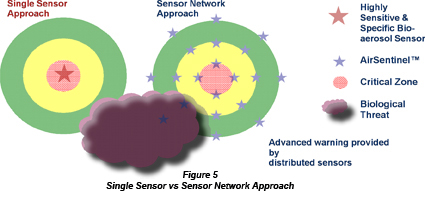 In the case of the two-tier surveillance model, sensors are distributed every
1000 square feet rather than in the center of the critical zone. The rationale
for distributed placement is to enable building operations systems to redirect
airflows to avoid contact with the critical zone. Advanced warning should enable
the building control system to respond with low-regret measures to prevent the
penetration of biothreats into the critical zone. The two models are illustrated
in Figure 5.
In the case of the two-tier surveillance model, sensors are distributed every
1000 square feet rather than in the center of the critical zone. The rationale
for distributed placement is to enable building operations systems to redirect
airflows to avoid contact with the critical zone. Advanced warning should enable
the building control system to respond with low-regret measures to prevent the
penetration of biothreats into the critical zone. The two models are illustrated
in Figure 5.
A distributed network of inexpensive, real-time biological sensors should enable advanced warning of a biological agent release because there is a high likelihood that one or more sensors in the network will be located near the source of the release. Furthermore, the sensor network can provide real-time information about the location of the source, the rate at which the agent is spreading, and to what parts of the building.
The distributed network of low cost sensors is similar to the smoke alarm approach used in buildings today. As with smoke alarms, building security personnel investigate the cause of the alarm and implement responses appropriate to the actual situation.
COST MODELING
Costs will differ substantially depending on the number of sensors used to protect the facility. While variations are endless, an example will be instructive and a simplified cost model to facilitate awareness of the possibilities and trade-offs is presented. The example compares the costs and performance using each independent platform to protect a hypothetical 200,000 square foot building.
To understand the comparative costs of ownership, we have modeled the costs to protect a hypothetical 200,000 square foot commercial office building. The cost assumptions are as follows:
The cost of an integrated system is $500,000 per unit
The cost of a dry filter unit is $1000 per unit
The cost of a distributed sensor (AirSentinel) is $1000 per unit
Capital equipment life is 5 years
Assay costs are $300 per suite of agents
Distributed sensor placement is one sensor per 1000 square feet
Dry filters or integrated detection systems are placed at five critical locations in the building (e.g., mail room, lobby, major HVAC zones).
The results for this set of assumptions are shown in figure 6 below. The analysis indicates that two-tiered sensor network has a substantially low total cost of ownership that either the dry filter or integration detection system approaches. The two-tier model balances modest up-front capital cost with very low operating cost. The costs are presented on a per square foot of real estate basis to see the effect that the system might have on the leasing rate if the cost is passed directly form the building owner to the tenants.

AIRSENTINEL BIO-THREAT SENSOR
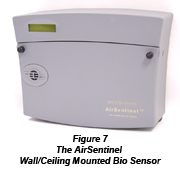 The AirSentinel is an early warning bio-threat sensor intended to be a “first
tier sensor” within a two-tier model for building security applications. This
innovative sensor was developed with assistance from DARPA (The US Defense
Advanced Research Projects Agency). The system detects concentration changes in
airborne biological particles. The sensor is mounted on a wall or ceiling and
networked into the existing building control system. The data output is
compatible with most building HVAC communication/control standards including
LONTalk® and BACNet®. The system has a wireless networking option.
The AirSentinel is an early warning bio-threat sensor intended to be a “first
tier sensor” within a two-tier model for building security applications. This
innovative sensor was developed with assistance from DARPA (The US Defense
Advanced Research Projects Agency). The system detects concentration changes in
airborne biological particles. The sensor is mounted on a wall or ceiling and
networked into the existing building control system. The data output is
compatible with most building HVAC communication/control standards including
LONTalk® and BACNet®. The system has a wireless networking option.
The AirSentinel employs a small pump that collects an air sample and delivers it via rotating impellers to the surface of an impactor or collection plate. This is a dry collection process. The collection process is adjustable: the longer the sampling time, the larger the sample thus improving the resultant sensitivity. The flow rate is 30 liters per minute and the collection efficiency is 50% over the 1-10 micron size range.
The operating phases of the AirSentinel may be understood as follows:
Indoor air is pumped into an impactor where particles are collected on a sample plate
Particles on the plate are exposed to UV light. A photo detector measures the florescence of the particles. The fluorescence intensity in wavelengths associated with biological particles is measured.
If elevated levels of fluorescence (indicative of biological organisms) is detected, an integrated air sampler is activated for several minutes, and is ready for confirmatory analysis. If not, the sample plate is cleaned and the automatic measurement cycle begins again.
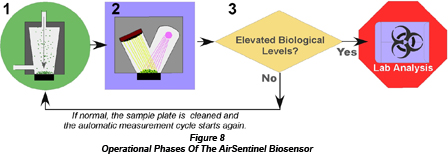
Laboratory and field testing of AirSentinel units is currently underway to fully-characterize the sensor performance. Results of this testing is expect to be available in May 2005. The product will be commercially available in late 2005.
[an error occurred while processing this directive] CONCLUSIONS
While no “silver bullet” sensor yet exists, practical real-time sensors are on the horizon that may be implemented with building control systems enabling active and automated response measures.
Approaches to protecting people and the buildings that house them from bio-threats are becoming economically feasible. Early stage obstacles to comprehensive bio-threat protection in buildings include the false alarm rate from the Tier 1 sensors and cost constraints with respect to the range of agents that can be tested for on each alarm. With this said, technical and logistical progress is enabling new options for building owners who seek proactive measures that can reduce mortality, reduce damage to the building and reduce remediation costs.
As affordable technologies for real time sensing of bio and chem agents become available over the next few years the biggest challenge to the buildings, and building control sector will be how to effectively implement protective strategies in buildings.
REFERENCES
Alibeck, K. Handelman, S. BioHazard. New York: Random House; 1999.
Harris, E. D. “Chemical and biological weapons: Prospects and priorities after September 11. The Brookings Review; 2002; 20 (3): 24-27.
Murch, R. S. “Forensic perspective on bioterrorism and the proliferation of bioweapons. In: Layne S. P. Beugelsdijk T. J., Patel C. K. N., eds. Biological Threats and Terrorism. Washington, DC: National Academy Press; 2002: 160-165.
Sensor Systems for Biological Agent Attacks: Protecting Buildings and Military Bases. The Committee on Materials and Manufacturing Processes for Advanced Sensors, National Research Council. Washington, DC: National Academy of Sciences. 2004. Accessed March 10, 2005.
About Mike Schell: Mike Schell is a consultant with MesoSystems Technologies
Inc. and is a principal in EpiphanyTec Inc, a consulting and sales organization
that specializes in championing innovative sensor and control technologies to
the buildings market. mschell@epiphanytec.com 805 687- 3175
[an error occurred while processing this directive]
[Click Banner To Learn More]
[Home Page] [The Automator] [About] [Subscribe ] [Contact Us]